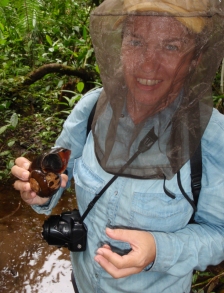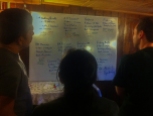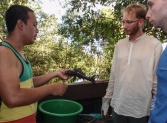 Something like a third of South America is taken up by the basin of the river Amazon. The outflow into the Atlantic is greater than the next seven largest rivers in the world combined and accounts for 20% of the freshwater flowing into the world’s seas. So we just had to visit it at some point on our trip. After spending the last week of March 2016 with a bit of a beach holiday in Zorritos on the north coast of Peru, we flew to Iquitos on Friday 1st April to start our Amazonian adventure with a conservation cruise up river of Iquitos. Part II of our Amazon blogs will describe our journey down the Amazon to Manaus in the heart of Brazil.
Something like a third of South America is taken up by the basin of the river Amazon. The outflow into the Atlantic is greater than the next seven largest rivers in the world combined and accounts for 20% of the freshwater flowing into the world’s seas. So we just had to visit it at some point on our trip. After spending the last week of March 2016 with a bit of a beach holiday in Zorritos on the north coast of Peru, we flew to Iquitos on Friday 1st April to start our Amazonian adventure with a conservation cruise up river of Iquitos. Part II of our Amazon blogs will describe our journey down the Amazon to Manaus in the heart of Brazil.
Bruce here…

Sunset over the Marañón river, a Peruvian tributory of the Amazon
Most of the Amazon basin is in Brazil, but there are substantial portions in the surrounding countries, from Surinam round to Bolivia. This means that there are a number of places to enter the Amazon but, as we wanted to see the main river itself, and we had a connection there, Iquitos in northern Peru was our stepping off point at the beginning of April 2016.

The April 2016 Pacaya-Samiria voluntary wildlife survey team (picture thanks to Bernard)
We had actually timed our Galapagos trip around our time in Iquitos. This came about through Richard Bodmer (a nephew of my old boss in Oxford), who has been an academic working in the Amazon for the last 30 years. A significant proportion of the funding for his research comes from Earth Watch, who have programmes whereby people pay to go and spend time helping with research in the field. Through his charity, FundAmazonia, Richard has been running wildlife monitoring surveys in the Pacaya-Samiria National Reserve for many years, trying to address conservation issues with both the Peruvian Government and the locals who live there. The Pacaya-Samiria park is up river of Iquitos, to the southwest, lying between the Marañón and Ucayali rivers, mighty rivers themselves. When we contacted him, he kindly invited us to join one of the Earth Watch surveys, the next one was due to start on Saturday 2nd April.

Pelicans flying past at sunset on the beach at Swiss Wassi
After we returned from the Galapagos and picked up the van from Guayaquil, we had about ten days to kill. So, we drove back into Peru, renewing our three month Peruvian visas in the process, and went to a lovely little campsite on the north coast.
 Swiss Wassi, run by Jacques (from Switzerland) and Melba (from Peru), was the nicest bit of beach we had found yet on the Pacific coast. It was a great place to set up camp and chill out for a week, enjoying the opportunity to stay still for a little while, before we caught the plane to Iquitos. We also left the van parked with them whilst we went to Iquitos and then spent a second stint here before moving off into the mountains.
Swiss Wassi, run by Jacques (from Switzerland) and Melba (from Peru), was the nicest bit of beach we had found yet on the Pacific coast. It was a great place to set up camp and chill out for a week, enjoying the opportunity to stay still for a little while, before we caught the plane to Iquitos. We also left the van parked with them whilst we went to Iquitos and then spent a second stint here before moving off into the mountains.
 One of our highlights of our stays here was seeing bioluminescence in the sea for the first time. We think we had been warned to look out for it by Melba (we still have a long way to go with our Spanish!) and tried to see it at midnight when it was raining. No joy that night so we were pleased when one evening after our return from the jungle, we were sitting there and spotted bioluminescence when the waves crashed. For us it was quite spectacular and could be seen a long way up and down the coast.
One of our highlights of our stays here was seeing bioluminescence in the sea for the first time. We think we had been warned to look out for it by Melba (we still have a long way to go with our Spanish!) and tried to see it at midnight when it was raining. No joy that night so we were pleased when one evening after our return from the jungle, we were sitting there and spotted bioluminescence when the waves crashed. For us it was quite spectacular and could be seen a long way up and down the coast.

The Peruvian coast near Lima
The irony of hub airports, plus the fact that you can only get to Iquitos by air or by boat, meant that, although we were directly due west of Iquitos, we had to fly south from Tumbes to change planes in Lima, adding a couple of thousand kilometres to the journey. When we arrived in Iquitos, we made our way straight to Casa Moray.
The Amazon was transformed in the late 19th century by the “rubber boom” when thousands of people came to harvest rubber by tapping the rubber trees in the Amazon. Iquitos and Manaus are two Amazon cities that grew up during this period and many beautiful buildings were built by those that made it rich, the “rubber barons”. Casa Moray is one of these rubber baron’s homes and Richard and Tula have restored into a really nice hotel (with 15 foot high ceilings!) as one of FundAmazonia’s conservation projects. This is Casa Moray today and the view from our bedroom window overlooking the waterfront:

A rubber boom boat restored as a museum by FundAmazonia
After a day to get to know the city a little, we meet up with everyone else in the dining room at Casa Moray for the first briefing of the trip. The next morning we were up early and had a tour of one of the river boats from the rubber boom, one of four owned and restored by FundAmazonia. This is now a permanent museum, which complements the fascinating Ethnographic Museum that is also part of FundAmazonia, and was our second port of call.
A bus ride took us upstream to Nauta, where we boarded the Rio Amazons, our home and research base camp for the week.

Becca using modern note-taking methods during our briefings (picture thanks to Yoko)
The journey upstream to the study site took a day and half, which were pleasantly spent with Richard introducing us to the ecology and geography of the Amazon, along with instruction as to how we were actually going to do the fieldwork, as well as plenty of opportunity to enjoy the Marañón river.


The fieldwork was well organised with a choice of seven activities each day to cover between the group. After the comprehensive briefing sessions, we all knew what we were supposed to do and were supervised closely by the field staff with us on the trip.
 The surveys included macaw counting and water bird counting , which were alternated, with one run from a small boat at dawn and the other at dusk. These proved very popular as there were a lot of birders on board!
The surveys included macaw counting and water bird counting , which were alternated, with one run from a small boat at dawn and the other at dusk. These proved very popular as there were a lot of birders on board!
 The dolphin transect also proved a popular option as it was a chance to see both pink Amazon River Dolphins and Grey Dolphins. This was done in a lovely, old restored tender.
The dolphin transect also proved a popular option as it was a chance to see both pink Amazon River Dolphins and Grey Dolphins. This was done in a lovely, old restored tender.

Spotting the lovely pink river dolphins

Bruce off to do a terrestrial survey (a walking transect)
The fishing and bat surveys also used these small fast boats.

Sometimes the surveys gave some additional wildlife treats, like a sloth or two…
The caiman surveys were done at night, using flash light from the bow of the boat to pipoint their eyes. Then, with a bit of luck, juveniles were caught to be measured before being put back in the water. Here’s Bruce delighted with finding an unusual Smooth Fronted Caiman and Becca happy to see a huge snail while out on a land transect.
The land transect was the only land based survey and, after everyone got bitten by mosquitos on the first one, they were not very popular. Volunteers could choose which surveys they did and could do as many, or as few, a day as they wanted, but each survey had to be covered by at least one volunteer. The land transect was the least popular and, as Becca and I hadn’t paid the full Earth Watch fees (we were covering our costs with FundAmazonia), we felt we should pick up the slack. We each did a transect where we were the only volunteer and another one together. Once we protected ourselves properly from the mossies, they were quite fun!

(picture thanks to Kathy & George)

The annual variation in river level is quite clear to see at the edges of the main river.
Much of the river basin is “flooded forest” and spends half of the year underwater. The water levels can vary by 15m over the year. The last decade has seen several years in succession of the highest levels of flooding on record, presumably because of climate changes. The wildlife surveys we were contributing to are recording the impact of these changes, as the specific species we were counting and measuring are “indicator species” that act as indicators of the health of the ecosystem below them.

The realities of life in a flooded forest
After a visit to a village on the edge of the reserve, whose residents are actively involved in the conservation of the reserve (several of whom had helped with the surveys), we returned back downstream to Iquitos.

Back in Iquitos, we were just in time to witness the first round of the Presidential election. Voting is compulsory in Peru and no alcohol is allowed to be sold for 48 hours beforehand. However, somehow we found ourselves in a bar that discretely put us (and other tourists) upstairs so that we could have a couple of beers whilst watching the early results come out!
 Below is a (large – it was a fascinating week!) gallery of more photos from our time on the Rio Amazonas and, below that (scroll to the end), is a separate gallery of photos from the market in Iquitos – the most interesting market we have visited yet. However, the market pictures come with a warning – life in the Amazon has always involved eating bush meat, such as turtles and caimans, the pictures of which some might find disturbing. As we learnt from Richard, this is not a simple issue of it being wrong or bad for conservation, as consumption that is controlled and sustainable is actually a more effective long term approach. Whether all the bush meat we saw in the market was legal or not is another matter…
Below is a (large – it was a fascinating week!) gallery of more photos from our time on the Rio Amazonas and, below that (scroll to the end), is a separate gallery of photos from the market in Iquitos – the most interesting market we have visited yet. However, the market pictures come with a warning – life in the Amazon has always involved eating bush meat, such as turtles and caimans, the pictures of which some might find disturbing. As we learnt from Richard, this is not a simple issue of it being wrong or bad for conservation, as consumption that is controlled and sustainable is actually a more effective long term approach. Whether all the bush meat we saw in the market was legal or not is another matter…
After couple of days in Iquitos, we embarked on a journey down river to Manaus, in the heart of Amazonian… (part II)
On the Rio Amazonas:


A visit to the exotic market in Iquitos:


















































































































































Love this post so many colourful photos looks really chilli pepper hot! How are Yellow Van mechanicals holding up as humidity must be a challenge? Our overland trip is now delayed due to health scare (Martine needs to complete treatment in UK) so will be on road early next year instead. Might first head East across Asia instead of starting in Americas as originally planned. Have you hear from Tiggers-Travels who are now in Canada? Safe travels and regards from Brexitland…
LikeLike
Thanks Rebecca, really interesting read. When are you back? Exx
LikeLike
Pingback: April down the Amazon II: Down river to Manaus | Yellow Van Days